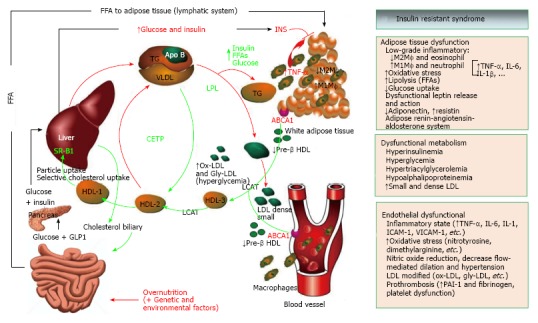Figure 4.

Insulin resistant syndrome and lipid metabolism. When obesity is developing, early abnormalities are observed at this time including hyperinsulinemia and low grade of proinflammatory state (↑ cytokines and PCR-hs), increase liberation of free fatty acids from adipose tissue (↑ lipolysis) and altered release of adipokines (↓ adiponectin, ↑leptin with leptin resistance). In some subjects, fatty liver develops later and consequently affects some functions of the liver. These include an early altered postprandial state (increasing glucose and triglyceride-rich VLDL particles), but finally these finding are observed in fasting state[289]. The VLDL particles undergo reduction by LPL and triglycerides are taken up by adipose tissue. The final result is the increase of cholesterol-rich small and dense LDL particles in serum. These LDL particles are highly susceptible to modifications like oxidation and glycation and the result is the increasing levels of ox-LDL, gly-LDL and the generation of antibodies to ox-LDL[190]. Finally, modified LDL are phagocytosed by macrophages in endothelial blood vessels and an inflammatory pattern that alters endothelial function initiating arteriosclerosis begins[177]. On the other hand, through ABC1 ligand the lipid efflux from peripheral cells to start the reverse transport of cholesterol is mediated. Mature HDL3 are generated from lipid-free apo A1 or lipid-poor pre-β1-HDL as the precursors, and LCAT-mediated sterification of cholesterol generates mature HDL3 and HDL2[189]. In T2D insulin-resistant patients, after adequate metabolic control the HDL3 cholesterol and APO A1 levels were increased. These findings were associated with a higher specific binding activity of HDL3 in those patients that showed improved insulin resistance[190]. Cholesterol efflux capacity has a strong inverse association with carotid intima-media thickness and was inversely associated with the incidence of cardiovascular events in a population-based cohort[188,290]. LCAT-mediated cholesterol esterification generates large spherical HDL2 particles, but large HDL2 can be converted in turn to small HDL3 upon CETP-mediated transfer of CE from HDL to apoB-containing lipoproteins, interfering with reverse cholesterol transport. Finally, SR-BI mediates the selective uptake of cholesteryl esters from HDL particles into mainly liver and steroidogenic organs[291]. VLDL: Very light density lipoprotein; LPL: Lipoprotein lipase; ox-LDL: Oxidized-LDL; gly-LDL: Glycated-LDL; ABC1: ATP-binding cassette transporter 1; LCAT: Lecithin cholesterol acyltransferase; CETP: Cholesteryl ester transfer protein; SR-BI: Scavenger receptor class-B, type I.
